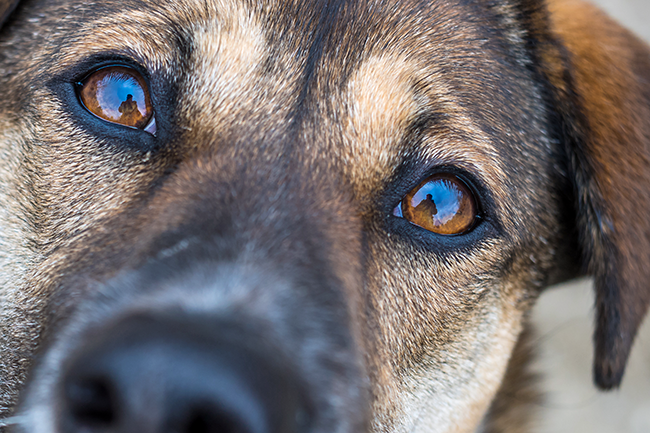If your dog has ever had red, watery eyes, you know how concerning it can be. Eye issues aren’t just uncomfortable for your pet - they can also point to underlying health problems.
One of the most common eye conditions in dogs is conjunctivitis, so let’s dive into what this condition is, how to spot it and when to seek veterinary advice with us at AAS Vets.
What is conjunctivitis in dogs?
Conjunctivitis is an inflammation of the conjunctiva, the thin membrane that lines the inner eyelid and covers the white part of the eye. It’s not just a human problem, dogs can get it too! The condition may affect one or both eyes and can be caused by various factors, from infections to allergens.

Symptoms of conjunctivitis in dogs
Knowing the signs of conjunctivitis can help you address the issue early.
Symptoms vary depending on the cause but typically include:
- Red or bloodshot eyes: One of the most noticeable signs.
- Watery or thick discharge: This could be clear, yellow or green.
- Swelling around the eyes: The tissue may appear puffy or irritated.
- Excessive blinking or squinting: Your dog might be trying to ease the discomfort.
- Pawing at the eyes: A sign that their eyes are itchy or sore.
If you notice any of these symptoms, it’s a good idea to seek veterinary advice here at AAS Vets.
Untreated conjunctivitis can lead to more serious eye issues, so acting quickly is essential.
Causes of conjunctivitis in dogs
Conjunctivitis isn’t a one-size-fits-all condition. Several factors can cause it, including:
- Allergies
Environmental allergens like pollen, dust, or mould can irritate your dog’s eyes, leading to conjunctivitis. - Infections
Both bacterial and viral infections are common culprits. - Foreign objects
Small particles like dirt, grass, or sand can irritate the eye and trigger conjunctivitis. - Dry eye
A condition where the eyes don’t produce enough tears, causing irritation. - Underlying health issues
Conjunctivitis can sometimes be linked to more significant health problems, such as autoimmune diseases or structural abnormalities in the eyes.
Treatment for dogs with conjunctivitis
Treating conjunctivitis depends on the underlying cause. Your vet will typically examine your dog’s eyes and may run tests to identify the problem. Here are the most common treatment options:
- Medicated eye drops or ointments
For bacterial infections, antibiotic drops or ointments are usually prescribed. Anti-inflammatory drops may also help reduce swelling and discomfort. - Allergy management
If allergens are the cause, your vet will recommend a treatment plan for this. - Removal of foreign objects
If something is stuck in your dog’s eye, your vet can safely remove it and provide treatment to prevent infection. - Addressing dry eye
Artificial tears or medications to stimulate tear production can help dogs with dry eye.
Most cases of conjunctivitis improve with professional treatment, but it’s essential to follow your vet’s instructions and complete the entire course of medication.
Comjunctivitis in Dogs FAQs
How Long Does Conjunctivitis in Dogs Last?
With professional treatment, mild cases of conjunctivitis often improve within a few days, and full recovery can take up to two weeks. However, untreated or severe cases may last longer and require more intensive care.
Are Some Dogs at Higher Risk for Conjunctivitis?
Yes, certain breeds are more prone to eye problems, including conjunctivitis. Breeds with prominent eyes, like Pugs, Bulldogs and Shih Tzus, are at higher risk due to their facial structure. Dogs with allergies or pre-existing eye conditions are also more susceptible.
Can Conjunctivitis Spread to Other Pets?
If the conjunctivitis is caused by an infection, it can be contagious to other dogs or even cats in your household. Keep affected pets separated and practice good hygiene, like washing your hands after treating their eyes.
Can I Use Human Eye Drops on My Dog?
No, human eye drops can contain ingredients that are harmful to dogs. Always consult veterinary advice before using any medication.
Preventing conjunctivitis in dogs
Prevention is key when it comes to your dog’s eye health. Here are a few tips:
- Regular grooming: Keep the fur around your dog’s eyes trimmed to reduce irritation.
- Frequent cleaning: Wipe your dog’s face gently after outdoor play to remove potential irritants.
Final thoughts
Conjunctivitis may seem daunting, but with prompt care and attention, most cases resolve quickly. Whether it’s through professional treatment or soothing home remedies, you can help your furry friend get back to their happy, tail-wagging self.
Keep an eye on your dog’s health, and if you notice redness, swelling or discharge, don’t hesitate to seek veterinary advice here at AAS Vets.








